Keepsake County’s Slapstick Stealth Shakes Up the Serious Stealth Genre
The ups and downs of developing a stealing simulator

I'm not sure about you, dear readers, but I stole. Not in the way that, say, professionals spend months training and preparing every bit of their elaborate heists to steal Monet paintings from some oil tycoon's summer villa. What I mean is that I have stolen once, way back in the bygone days when Max Payne still had hair and pimple-faced, Dr. Pepper-fueled gamers like myself still dreamed of something like Resident Evil 2 in VR.
I remember the feeling with every fibre in my bones: the slowness of time, buckets of sweating before you decide to go for it and put Thomas Jefferson winking at you in your pocket. It might have not been much. Yet, at the time, the heaviness of this single action felt as if you might be sent to Guantánamo Bay for life. No more careless, Cheetos-fingered lollygagging in front of the television screen, young man.
What I'm trying to say is this: stealing is bad... but can be very electrifying in that "Dastardly" way that Red Dead Redemption rewards you for with an achievement when you're hogtying a damsel in distress to a train track. Also: unless it's a copy of Nintendo Power's very first issue that you found in your local cafe's dusty old shelf - don't steal, kids.
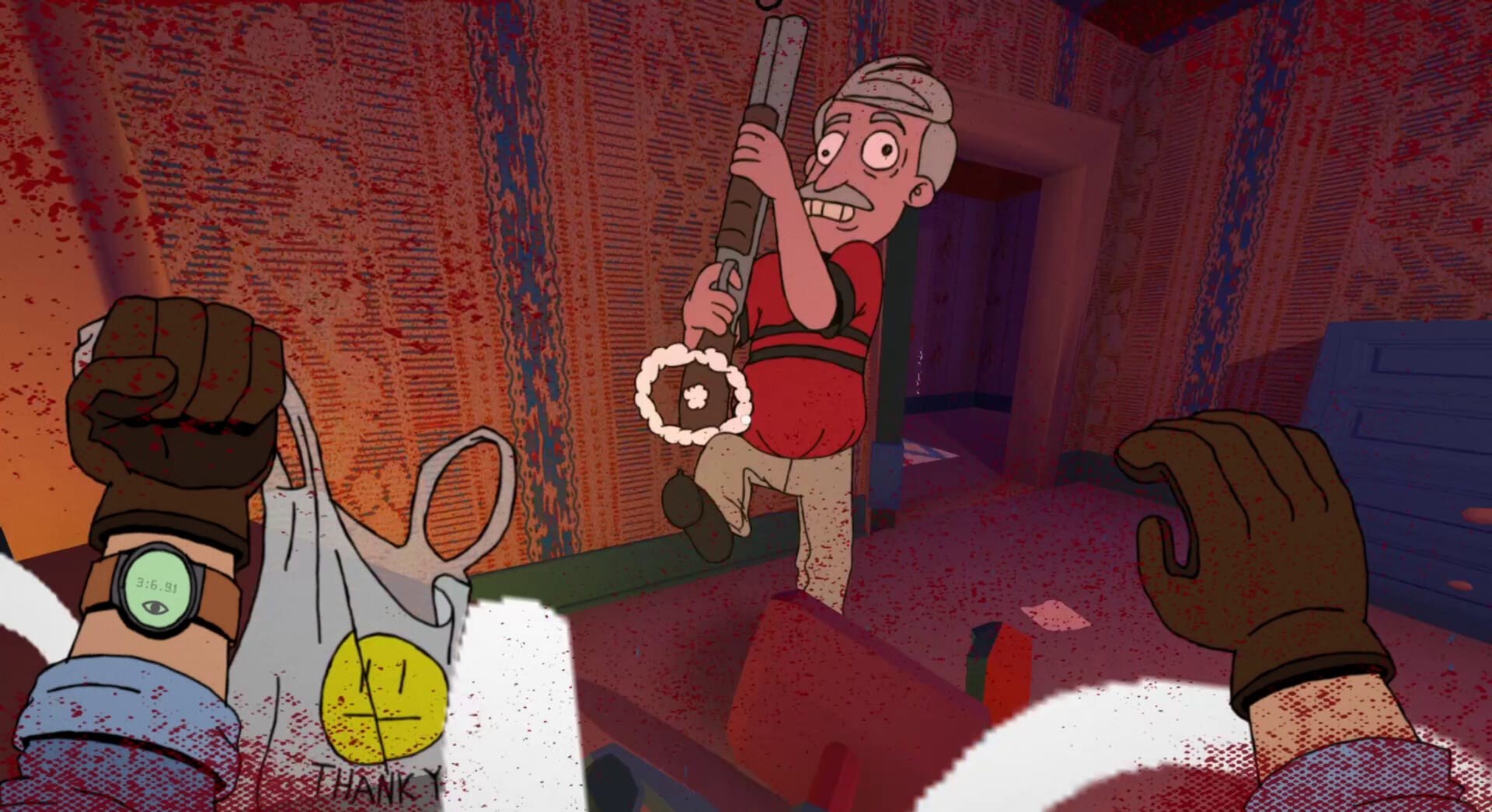
Video games, in my personal opinion, have a pretty weird relationship with the act of stealing. When you do it as Sony's own virtual Indiana Jones (Nathan Drake) with his charming ol' million-dollar smile, it's fun and bears as much weight on your consciousness as listening to "Stairway to Heaven" past bedtime. When you do it as Thief's Garrett or, say, GTA San Andrea's CJ during that one mission where you're robbing everything that's not nailed down from some rando's home - there is a pang of thrill in the possibility that you will get caught red-handed. Then again, even if that does happen, checkpoints serve as the ultimate "Get Out of Jail Free" card in these games. So much for the immersion of being a virtual burglar...
Forward Instinct's thieving simulator, Keepsake County, then, comes to raise those stakes - shake things up too, both figuratively and literally. You see, it's a procedurally generated game where you are playing as a burglar stuck in the "America's Breadbasket," aka the Midwest. Also, and this is important: it's a rogue-lite, just like Spelunky or XCOM 2 (at least in 'Ironman' mode). This means that once you get busted - you get busted, mister. All your progress, all those houses you 'cleaned' real good, all the swifty perks you purchased at the diner - *poof* gone.
When you return to the same house for another run, the basement window you used as an escape route last time might now be a wall of bricks. The safe with all those extra valuable blueprints you read about in the newspaper? No, yeah, those will probably be tucked away in another room now. So like Nolan's Inception but with the game and not your mind playing tricks on you.
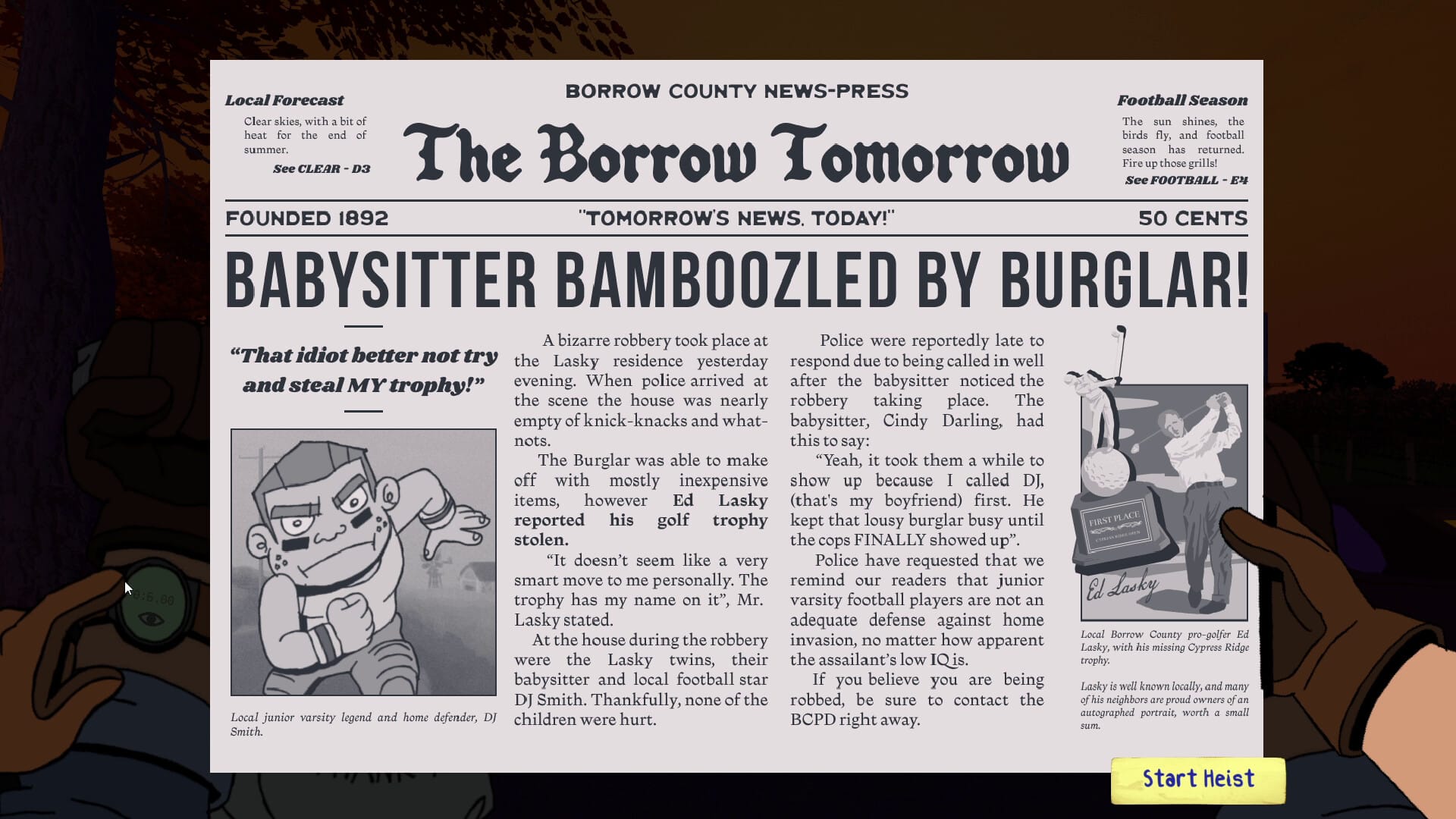
"Something that I find myself doing when I'm playing Dishonored is doing perfect runs. What you wind up doing is just saving a million times, trying something, and being like, ‘Oh, that's a bad idea.’ Then you restart..."
While Daniel Pomidor, the founder of Forward Instinct and mastermind behind Keepsake County, didn't follow this by saying that his game is the antithesis of 'scumming', that's precisely what's so beautiful about Keepsake County. After all, how many games invite you to have some big ol' fun by making you run headfirst into a bag full of complications and roll with the punches?
SUPERJUMP: First of all, congratulations on releasing a newer version of Keepsake Country’s demo. Can you tell us what the reception of your game has been so far?
Daniel Pomidor (lead developer): It's been interesting. So first off, DreamHack went pretty well. [Deus Ex’s] Warren Spector was on the judging jury which was cool (he is a great guy). We also got 'The Best Audio' [award], runner-up in 'The Most Fun' [category], and third place in 'The Best Design'. Which was nice because we haven't had a publisher; we've just been doing this in our spare time, between jobs and all sorts of things.
As far as reception, I think it's kind of an aesthetically left-field game. It's designed to be like an immersive sim with procedural generation elements so that you're thinking on your feet. So it's been a mixture of people that are really attracted to it. I'll take it to a game conference and it's people who are saying, ‘I don't normally like Dishonored or Assassin's Creed - I don't like killing people.’ But they play it because it looks cute. And they've never played an immersive sim before. So Keepsake County winds up as an entry point because it is a little bit less complex.
It's been generally pretty positive partly because it's just very different from what a normal immersive sim is. We're getting both new audiences and surprising the people who normally play those.
SUPERJUMP: I've seen a comment in one of Keepsake County's videos that said: 'While I love the art style and premise, I'm not really into the stealing from normal people thing.'
Daniel Pomidor: I mean... [takes a deep breath] That's a bit of a goofy sentiment to me. But I also do understand it. You are technically robbing rural people.
You know, the game used to be a little bit darker. One of my initial inspirations was The Town That Dreaded Sundown, which is this movie from the late '70s [about] a weird, terrifying serial killer story that took place in the '50s. I hadn't seen it, only the poster. And I was like, ‘Wow, this looks cool! I wonder what it'd be like making an asymmetrical game where one person's the serial killer and the other people are in houses.’ Kind of like Trouble in Terrorist Town and Among Us.
We had a prototype of that, it was pretty fun. But we couldn't keep the networking working – it was just out of our skill range. So we left that and went to work on some other projects. Then the pandemic happened and we were like, ‘Oh, this is miserable. Can we just go do something smaller like Midnight Ultra?’
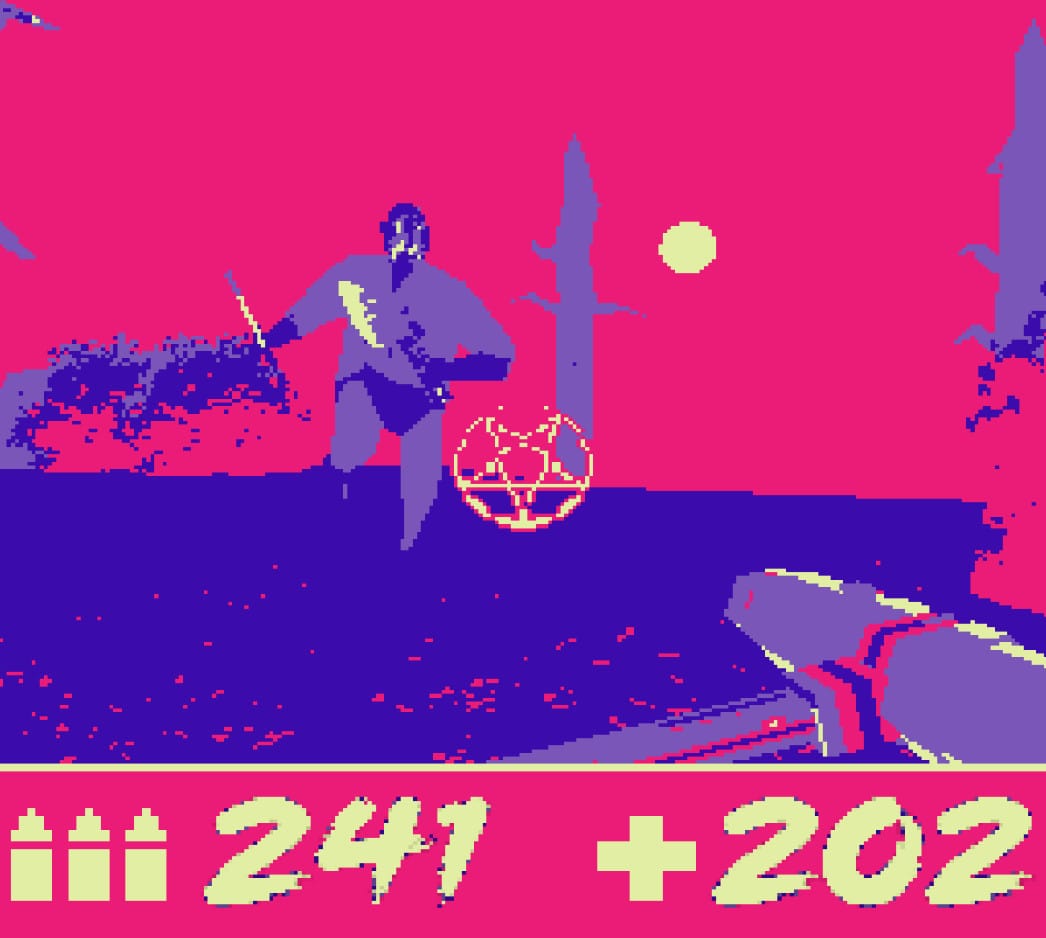
Keepsake County was originally called The Neighbours. It was about suspecting your neighbours. Then we started thinking, ‘What's the most interesting person to play as in this game?’ It's the serial killer dude who's going into these houses. But that's way too dark.
My friends, family, and people I know have been struggling for four or five years because of the state of America right now. So I took a lot of inspiration from Kentucky Route Zero. You know, let's make [Keepsake County] a little bit of a satire. A fun way of making fun of the grind. ‘I'm doing all this work, trying to pay off this enormous debt of mine and it's barely doing anything.’ I think there's a lot of humour to be found in that.
SUPERJUMP: You mentioned that Keepsake County began as The Neighbors. What were the origins of that game besides The Town That Dreaded Sundown poster?
Daniel Pomidor: I really liked multiplayer games in general. I played a good amount of them. When I was in college, designing stuff was kind of how I cut my teeth [in game making]. We had this game called DAEMON, which was like a live-action game where people were running around with AR headsets and shooting each other with Nerf guns. So I always had a multiplayer game mindset - at this point, I have almost 20 years of Team Fortress 2 experience. [laughs]
I think I get some of my best ideas when I hear about a game, but don't play it. Bobby [Matsudaira], our animator, he got this joke with a real punchline he told me back in college. One day he goes, ‘Have I told you about the three rules of frogs?’ And I was like, no. He got distracted and went off to do something else. But it was just me walking around for the rest of the day thinking about the three rules for frogs. Years later the joke came up again and I was like, ‘Don't tell me what the joke is!’ Because sitting here thinking about what the three rules for frogs are is way funnier than the actual punchline.
I never played Trouble in Terrorist Town. But the idea of it and thinking about how that works is funny to me. Midnight Ultra was a game that we designed and I hadn't played the original Doom, only the 2016 [version]. So Midnight Ultra was me thinking about what could this game possibly look like that people [during the] Satanic Panic days worried about. Kind of like the artistic game of Broken Telephone.
SUPERJUMP: The game’s description says ‘procedurally generated’ and ‘roguelike.’ So how do these two elements paint in a game like Keepsake County?
Daniel Pomidor: When we were designing Keepsake County, one of the original inspirations was Spelunky. There was this fixation to know how procedural generation works because at the time, as someone who's more design-focused and not as heavy of a programmer, procedural generation was this black box. It seems like it just vastly expands content and experience in a way people enjoy.
I played a lot of Dishonored and Cruelty Squad. And that was an inspiration on Keepsake County’s mechanics and just kind of the scope of it. Then I started thinking, ‘What if you made a procedurally generated stealth game?’
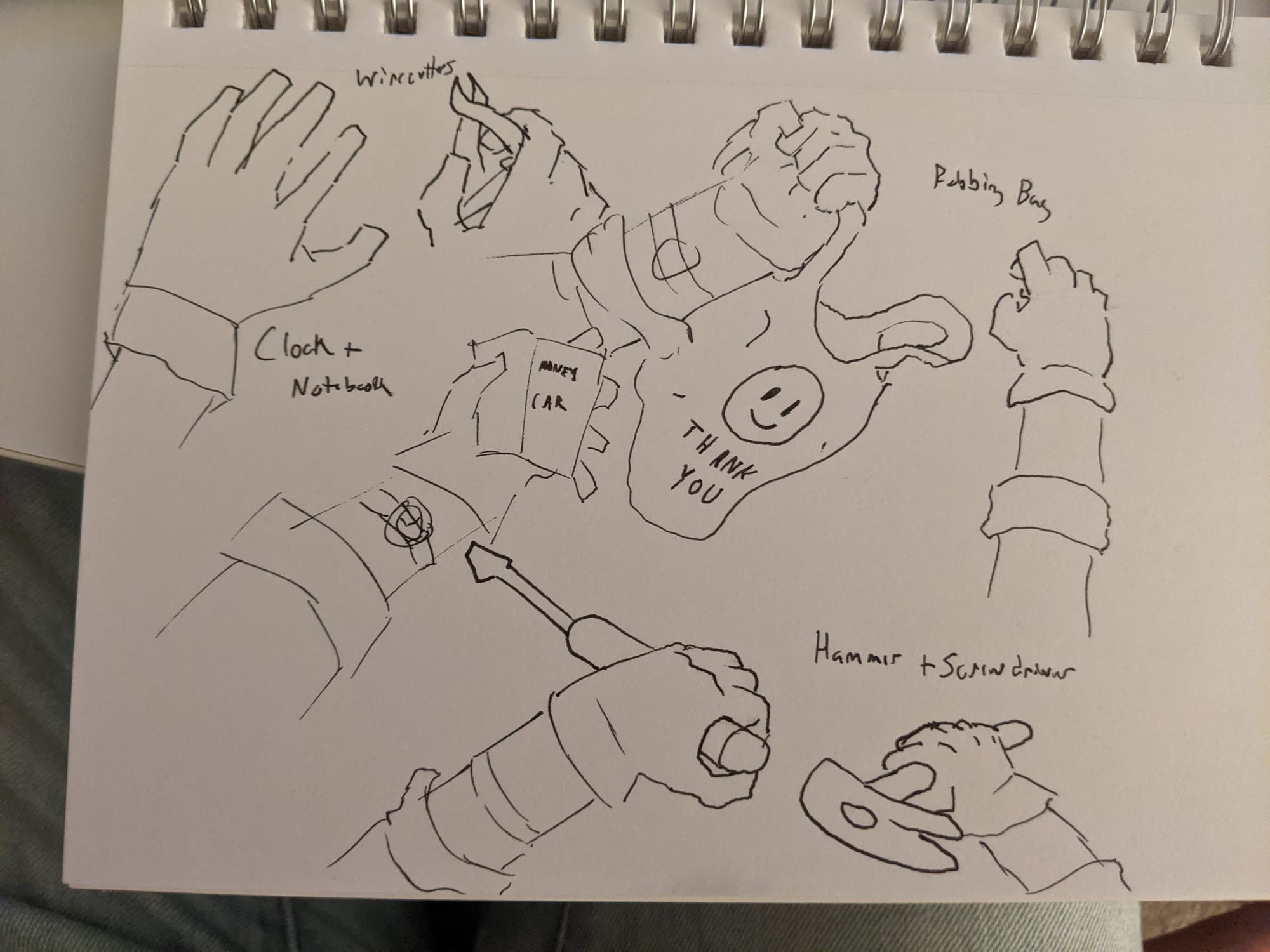
Something that I find myself doing when I'm playing Dishonored is doing perfect runs. And what you wind up doing is just saving a million times and trying something and be like, ‘Oh, that's a bad idea.’ Then you restart. So Keepsake County is more about the hillbilly logic and shit hitting the fan constantly in a really funny way. Doing procedural generation is more about thinking on your feet and not memorizing stuff.
Hook Mansion, for example, is always in a hook. It has a basement, a second floor, and the front door in the same spot. But then all the other doors and windows and rooms are shifted around. There might be a trampoline conveniently placed outside next to a vine wall, which might turn into a completely flat wall - then you've got to have a completely different entrance.
SUPERJUMP: That explains a lot. Since it's a roguelike game, in which players will be repeating levels over and over again, does procedural generation help keep things 'spicy'?
Daniel Pomidor: We now have the perk system between the levels which gives you a little bit of a sense of progression. So we're going to be adding new perks and tying it to the money that you make between the levels.
We also have a lot of different environments. There’s a weather system in the plans. We want to add tornadoes. Probably the most like Midwestern thing you could imagine is robbing a house during a tornado. [laughs]
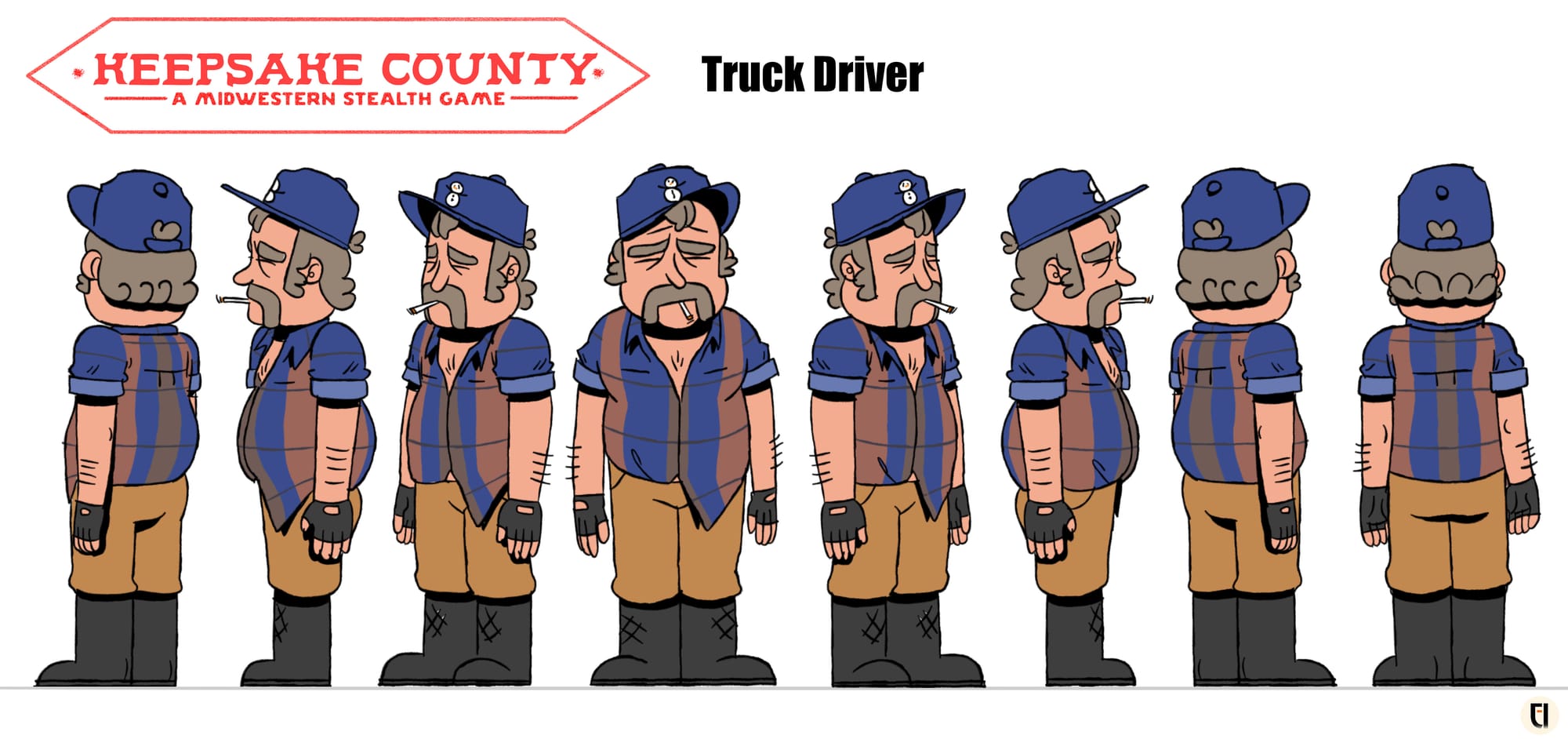
I don't want to run out in front of the car here and then get hit by it, but we have a lot of stuff planned as far as difficulty is concerned. On some levels, you are somewhat wanted. There's a billboard that has your face on it. So people are starting to be a little bit more aware that there is a burglar out and around. The architect level starts to introduce that a bit. There's two cops already there [at the start of the mission]. When you get the cops called on you, the detective shows up immediately rather than later.
That's all going to be really fun ramping the difficulty in both making the interior of the house more difficult and the exterior harder to navigate. The AI are not necessarily going to get smarter, but it will put more traps for you.
SUPERJUMP: The art style of Keepsake County, which brings to mind wacky, MTV-like humour, is definitely one of its central hooks. Can you tell us how you came up with this direction for your game?
Daniel Pomidor: When we were originally designing the game, there was this idea that each person you were going to rob was just going to be horrifically ugly. [laughs]
It's funny you mentioned MTV and Adult Swim because Will [Laren] did a lot of stuff for Adult Swim for a while. He's got all these really goofy comics and risograph posters. Have you seen The Spicy Keychain comic? That was a big inspiration in terms of the characters you'd be robbing.
Of course, Bobby has his own unique style of drawing. One of the games he’s been inspired by was Gihan Wilson's The Ultimate Haunted House. We also like Rugrats and Courage the Cowardly Dog - that kind of 90s era of animation. Bobby is an animator and it was through him that I had this idea of doing all the characters in risograph. It's very colorful and you get strong halftone grain. I don't have access to a risograph machine anymore and it would have been horrendously expensive to do that...
So what we wound up doing was filter characters through his own aesthetic, keeping them a little unsettling looking. For example, the babysitter - she's a little cute, I guess. But she's also like, ‘Oh, I don't like you.’ That was an important thing about the enemies - making them not likable.
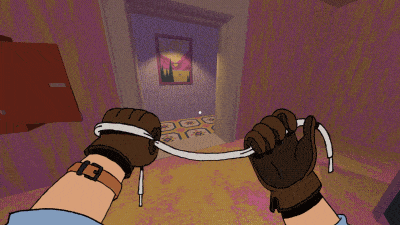
SUPERJUMP: Is there a reason why Keepsake County is set in the Midwest specifically?
Daniel Pomidor: Part of it is that I'm from Ohio. Lived there for 10 years. And I have friends who are from the Midwest. So we have that kind of informed experience.
Another part of it is a little bit of that frog rules thing; of making a game and then titling it a ‘Midwestern stealth game’. Your brain immediately starts to question ‘What is that?’. It's not a normal place that you'd have a stealth game, right? It's these wide, open expanses where you're not stealing some sort of artifact. So to me [Keepsake County] is this thought-provoking, fun challenge of ‘How do we do this?’
Also, a big reason why I wanted to set it in the Midwest was trying to do something that was just different; something that would not invite the comparison to Thief or Dishonored. I've since been made aware of Thief Simulator (it's insanely popular!). So I thought I’m going to look like a doofus for not having played Thief Simulator. At the same time, it's good to be kind of pulling from my own thing and not have played it.
SUPERJUMP: Perhaps some members of your team have been robbed or have similar first-hand experiences?
Daniel Pomidor: No. I know some people who have been robbed though. It's obviously a terrible experience.
I remember talking to someone and throwing the game idea at them, and they were like, ‘I've been robbed before.’ And I was like, ‘Oh God...’ That's why I think the levity of this is important. Trying to put a light spin on it.
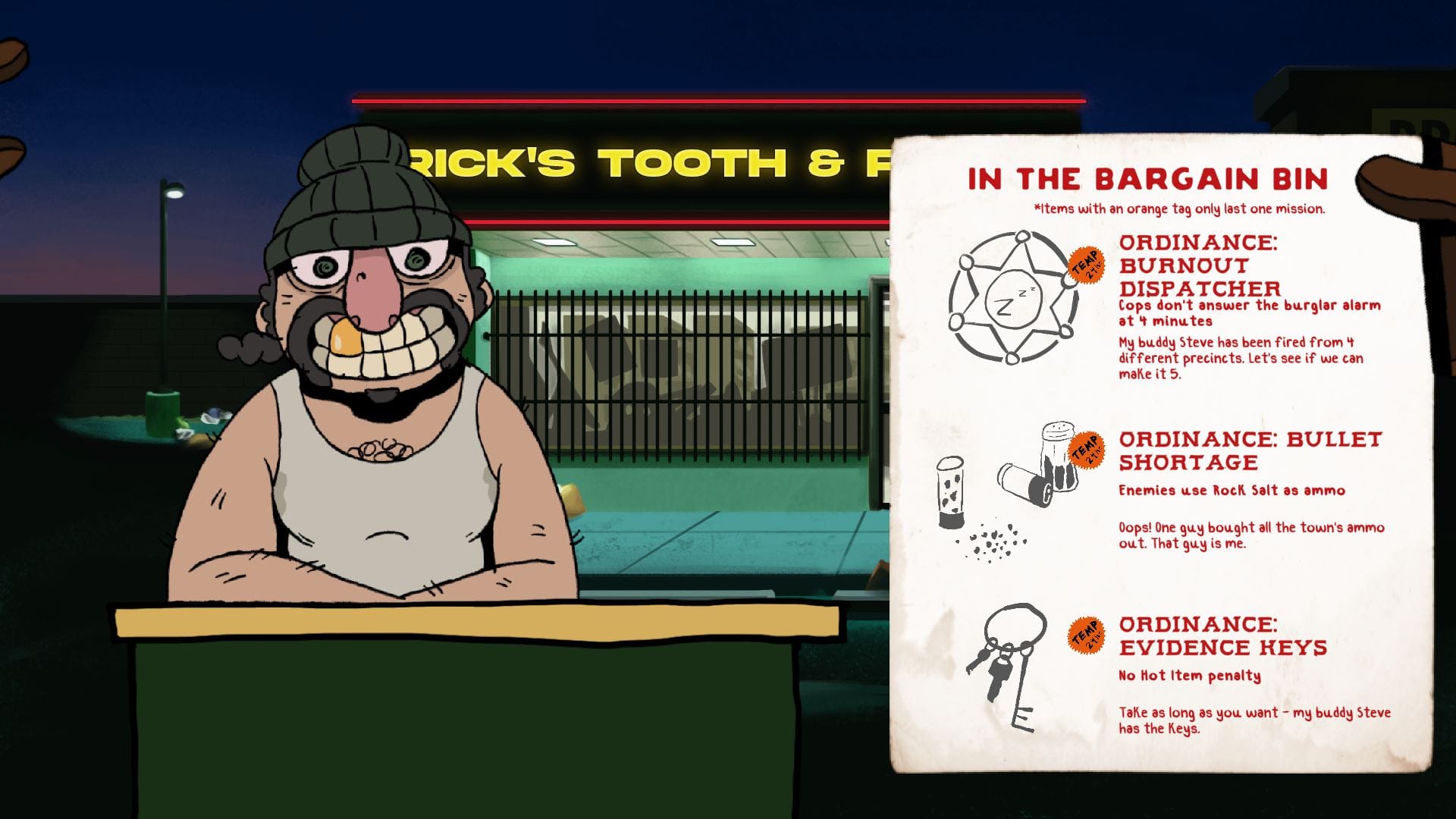
When people playtest Keepsake County, a lot of people see the hammer in their hands and they [instantly] try running up to the civilians to kill them. It's not always your typical gamer gamer that does, that. And it doesn't come from a dark place or anything like that. But [usually] games are pretty violent - your only method of interaction in [most] games is shooting. That's where I think a lot of people's heads go. But it would make [Keepsake County] boring. It wouldn't really be adding anything to the conversation or making an interesting game.
So to me, it’s kind of important to keep the game jokey and weird and non-violent. It's far more interesting when you can't be dark. It's the difference between “Apples to Apples” and “Cards Against Humanity”. [laughs]
SUPERJUMP: How does the endgame of Keepsake County look? Is it similar to Slay The Spire where your goal is to beat all missions in one run?
Daniel Pomidor: That's generally the goal, yes. From there on out, we’re mixing the story stuff into it, so that players are experiencing something while they're at it.
But I will say that, at least to me, Keepsake County is more about the journey than it is necessarily about the goal of paying off your enormous debt. That will be something that we're currently playing with in terms of the story.
SUPERJUMP: Are there any particular lessons or experiences you brought from Midnight Ultra to this project?
Daniel Pomidor: Yeah. AI has been very complex for us. Obviously, it's not like triple-A level stuff (if somebody looked through my code, they would probably start crying). But learning to do patrol paths and making AI interesting to play against in Midnight Ultra was challenging. I got a lot of complaints about how movement felt in Midnight Ultra from various people - it's exactly what I wanted but not what everybody else wanted.
Also, some of the meta stuff: how do you release a game, why do you release a game, how do you talk to an audience while making a game? I think we've improved from where we were during Midnight Ultra in terms of polish and just taking our time with it; really listening to people's feedback.
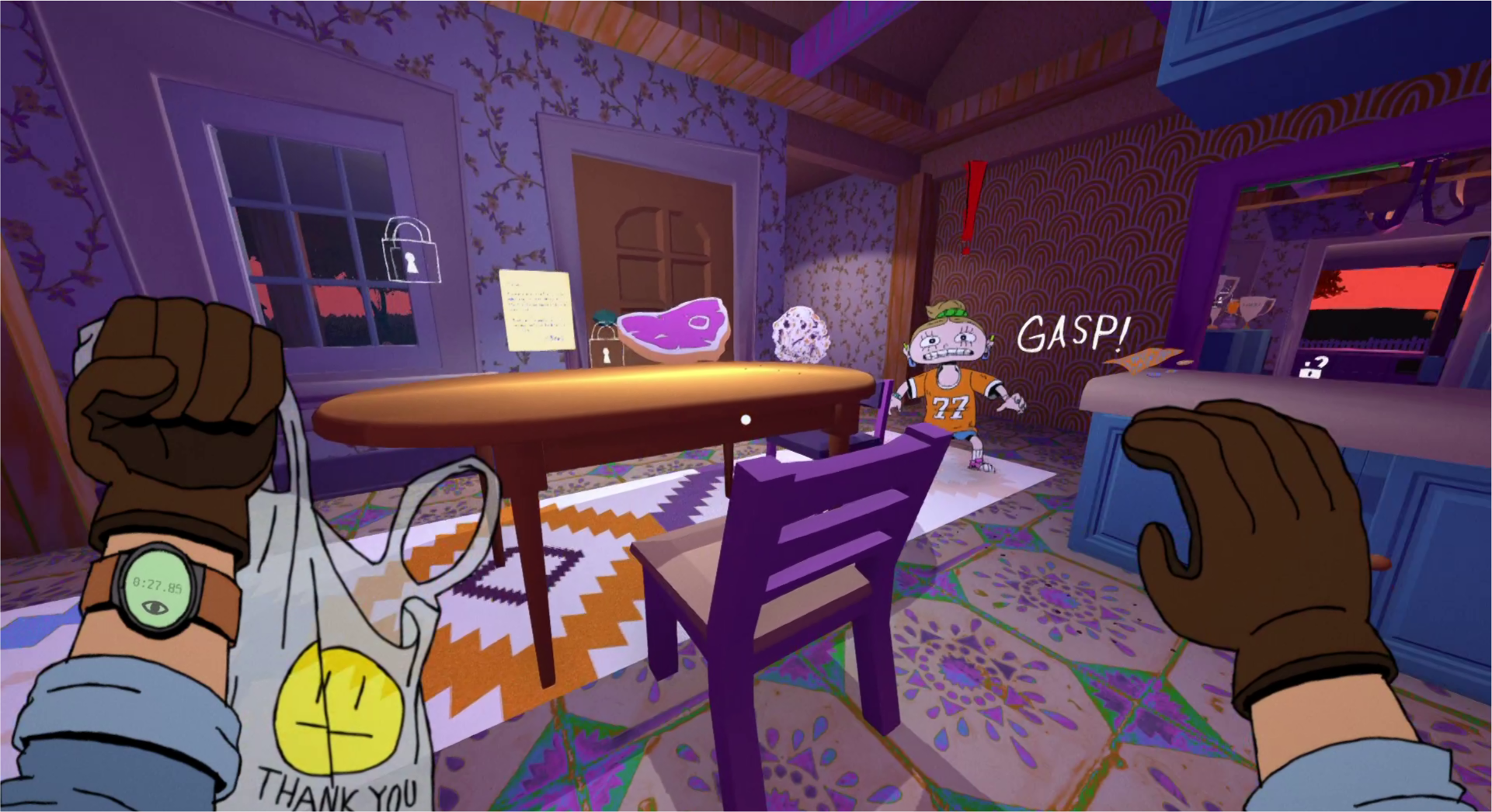
The game environment, the ecosystem of releasing a game on Steam now versus 2017, has changed, too. When we put out Midnight Ultra on Steam, the number of games released on Steam was around 5000 a year. Now, there are a lot more games being put out on Steam. The number of steps that you have to go through to put something out on Steam successfully and intelligently is very different. I think the audiences have changed too. Navigating that and thinking about how to do it properly has been a really big learning point for us.
SUPERJUMP: It’s been more than two years since Keepsake County was announced. Did you plan for it to take so long to be released?
Daniel Pomidor: I'm going to be on the level as best I can here. I started making Keepsake County when I was in a different situation. I could spare the time to work on it every day after work. We made the alpha, we had a pitch deck - we were pitching it and people really liked it. We were like, ‘We're going to be able to work on this full-time soon!’ That was not the case.
For a good year and a half of having the expectation that we will maybe be able to do this full-time, it hurts your instincts to scope your game when you know it could have a much wider scope than it should. That was something we were figuring out the whole time.
But yeah, I didn't plan for it to take this long. If somebody had come over and said, ‘Hey, you're never getting signed. So just make the best thing you can,’ it probably wouldn't have been that different from where we are now.
We're in a state now where I think we know what we want to do, the scope, and [the] things we want to see in the final version of Keepsake County. Meeting as a team again and being like, ‘We don't have to worry about this imaginary pie in the sky. So let's just get it out.’